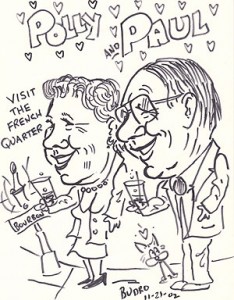ASA December 2010 AN Column
Paul L. Doughty, Contributing Editor and Secretary
I write this amid an abundance of general excitement: the fall elections with fact-less analyses, avalanches of cash and the rejection by many of fact for fiction; war and bombings, disaster frustrations and frauds, murderous drug cartels and their victims; and then, finally something to cheer for other than sports—the Chilean mine rescues. As millions of people around the world found joy in watching miners emerge from the “earth capsule” to be embraced by family members and Chileans became enraptured by a sense of comradeship, I couldn’t help but reflect on Walter Goldschmidt’s last book, The Bridge to Humanity: How Affect Hunger Trumps the Selfish Gene.
As in almost all disasters, when peril and affliction are shared, community cohesion is significantly revived, concern for the other manifested, affection expressed and acted on. Communities become engaged across societal divisions in common cause. But it is difficult to build on this base, perpetuating the positive and constructive social values that provide succor during crises that can enable a society to become better in collectively resolving serious problems. Yet, those not closely involved slip away to other matters, and the situation may inspire some to take advantage of societal plight. In our day, the latest “breaking news” often takes us on paths of trivial pursuit, a distraction from problems that diverts attention from important affairs. Such management of the public recalls both George Orwell’s 1984 prolies and Aldous Huxley’s Brave New World of pleasurable distraction and manipulation; both were written in the context of the worldwide depression of the 1930s.
Viewing US public affairs today, one feels and sees disagreement and divisions criss-crossing through the cultural and social fabric as a perverse weave, a herringbone pattern gone awry. In a scientific and scholarly sense this panorama of human behavior is a banquet table set for the anthropologist and those in other social sciences. Do we have the theoretical, methodological and applied tools to analyze, explain and promote understanding of these phenomena, and moreover, do we have the commitment and willingness to utilize this knowledge on behalf of the common welfare, across the boundaries of culture, power and faith?
Over the past several years, I have perceived a significant shift in anthropological perspectives, from the old essentially “hands off” approach to today’s focus on engagement in resolving the many cultural dilemmas of conflict, well-being, respect, exploitation and domination that confront people everywhere. A cursory review of American Anthropologist (AA) through AnthroSource indicates that as the Great Depression sank its roots into society, many colleagues in the early 1930s seemed not to involve themselves professionally in that arena. But interest in acculturation grew and Ralph Linton’s famous article in American Mercury (1937), “One Hundred Percent American,” began to raise public awareness of global connections. He had already used much of that article in his landmark text, The Study of Man (1936). We may take note that 1936 was the “breakout” year for a modernizing anthropology as the “Memorandum on the Study of Acculturation” by Redfield, Linton and Herskovits (AA, 1936) had the effect of giving permission to research cultural change in all its dimensions, and not just using the ethnographic present approach that was so dominant in our past.
Thus the business of understanding the other continues and fits well into current issues and affairs as we again develop xenophobic fears inspired by confrontations with people whose societies we fail to understand. Could the need for a tight bond between the theoretical and applied branches of our discipline be more acute than it is today? Or, the need to put our research-derived findings into the public arena to aid all of us in coping with a conflicted world of 6.6 billion people?
Along this theme, our ASA book documenting some of the changes that greatly enlarged the scope of the discipline in the post–World War II era, Expanding American Anthropology 1945–1980 (forthcoming, University of Alabama Press) was advertised at the meetings and will be available shortly. The book contains 22 chapters based on papers given at recent ASA sessions that cover a wide range of topics.

